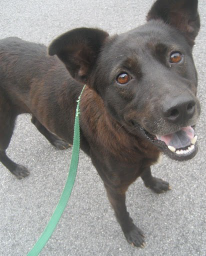Your new dog is a stranger in a strange land
Imagine how you would feel if you were dropped into a foreign country where you did not speak the language, you didn’t have any money, and you didn’t know how to get your needs met. How scary would that be? Imagine if every time you did something wrong or tried to ask a question, someone yelled “NO!” at you? How scary and difficult would it be to learn the language and how to get a meal? That is exactly what we do with rescue dogs. These dogs don’t know how to get their needs met. They don’t know if they’re safe. They don’t know who to trust, and they don’t speak English.

Many of our rescue dogs come from unknown backgrounds. We don’t know if they have ever been hit, yelled at or abused. We also don’t know what they have seen or been socialized to. Yet we expect them to know and follow our rules. We think they should know how they are supposed to behave. They should know what they are and are not supposed to chew on. We think they should know where the bathroom is and how to tell us they need to go, the list goes on and on.
By showing your new dog kindness and compassion through positive training – being clear on your expectations, and rewarding behaviors you want more of and preventing behaviors you don’t want more of – you will set your newly adopted rescue dog up success with you in your home.
When and how to get started on training
The best time to start on training your new dog is the first day you bring your dog home. Training on the first day is all about setting your dog up for success. Establish routines, boundaries, and habits to last a lifetime with your dog. Keep things simple. Reward behaviors you want more of – like sitting for petting and not jumping, sitting to have the leash put on, and politely waiting for a food bowl. Make sure to not reward behaviors you don’t want more of. Yelling at or trying to correct a dog for jumping gives the dog a simple message “I love it when you do that! Please do it again!” because to a dog, all attention is good attention (they can’t easily differentiate between good attention and bad attention).
Of course, you can’t always just ignore behavior that you don’t like in your new dog. Behaviors like trying to run out of doors, jumping up on people, and stealing things off the counter are all things that we don’t want more of, so we need to prevent from happening in the first place. By simply following the two-week shutdown rule and keeping your dog on a leash, you can prevent your dog from running out the front door, jumping up on people, and stealing things off of the counter.
2 Simple things to do with your new rescue dog
Dog on leash have fewer house training accidents. If your dog is on the leash and you are paying attention to her, you will notice when she starts to sniff the floor or walk in a circle or start to squat – all signs that she is about to go to the bathroom – you can quickly run her outside your potty spot.
You should also keep your dog’s world small. Your dog does not need access to your entire house on day 1. Start by handing him in one or 2 rooms – with you actively supervising him on leash to prevent chewing problems and house soiling accidents.
What training methods work best with rescue dogs?
We recommend you use positive reinforcement training with your newly adopted dog. The premise of positive reinforcement training is simple: you reward behaviors you want more of. You also prevent behaviors you don’t want more of by using a leash or crate or active supervision. This prevents the dog from rehearsing unwanted behaviors. The more your dog rehearses behaviors that you like, the more he’ll realize how to get his needs met. He will offer these pleasant and positive behaviors more and more, because they work for him. Rewards that your dog can earn are food, treats, play and toys, access to the yard or a walk, petting, and praise. Consistency and contingency are key. They speed up your dog’s learning because he learns that he has the power to make things happen.
Why we don’t recommend shock collars and prong collars
Tools like shock collars, prong collars, e-collars, choke colors, pinch collars are all punishment-based training methods. The premise of punishment-based training is the dog learns how to avoid pain or fear. Punishment does not teach the dog what he is supposed to do. Dogs can have their necks punctured by prong collars if they suddenly pull or lunge. Prong collars can also pop off without warning. Choke collars can crush tracheas. Shock collars or e-collars can make dogs nervous, fearful, and unpredictable in situations they find scary or intimidating.
Almost all aggressive behavior is rooted in the dog being fearful. By punishing the dog for telling you he’s afraid – be it a growl, snarl, or refusal to do something – you do not make the dog’s fear go away. The dog learns that it’s not safe to show you he’s afraid, so behavior can be much more unpredictable. Also, if you punish a dog for growling, you risk him escalating his behavior the next time he’s afraid. The next time he is afraid, instead of saying “I am afraid” with a growl, he may say “I am afraid” with the snap because the last time he growled it got him a shock to his neck and the scary thing didn’t go away. For more information on the negative effects of punishment-based training, read this article published by the American Veterinary Society of Animal Behavior: https://avsab.org/wp-content/uploads/2018/03/Punishment_Position_Statement-download_-_10-6-14.pdf
Training and bonding takes time and patience
Studies have documented that it takes 3-4 days for dogs’ stress hormones to return to normal after going to a new home. It can take 3-4 weeks for the dog to feel safe, and 3-6 months for his personality to start to really show. What this means to the new dog owner is that it will take time and patience for you and your new dog to settle in and feel comfortable with each other. Look for teachable moments in the first few weeks with your dog. Teach them to say please and they say it over and over again when they want something.
If you find yourself feeling overwhelmed, in over your head, or don’t know what to do with your new dog – ask for help! A class or few lessons with a positive reinforcement trainer are very effective ways to get started on a great life with their dog. If you see behavior that looks aggressive or scary, definitely don’t wait to ask for help. The longer you wait to start to change this behavior the harder the process can be and the lower the likelihood for success.
About Pepper’s Paws Dog Training
Pepper’s Paws, LLC provides in home dog training for basic manners, behavior problems, and fear aggression in Rehoboth Beach, DE. We also offer private, in home lessons in Rehoboth Beach, Lewes, Bethany Beach and surrounding communities. Zoom lessons are available dog training and behavior modification if you do not live in our service area.
Head trainer Deb Murray, is Certified Canine Behavior Consultant (CBCC-KA) and Certified Professional Dog Training (CPDT-KA) by the Certification Council of Professional Dog Trainers, a Fear Free Certified Trainer, an AKC Evaluator, and a Distinguished Graduate and Mentor Trainer for the Catch Canine Academy.
